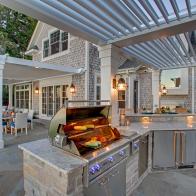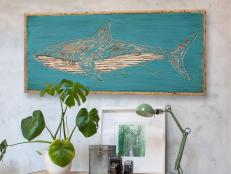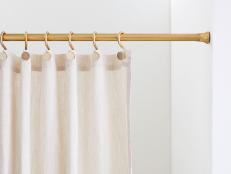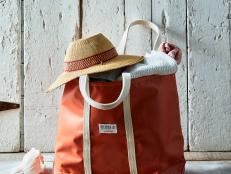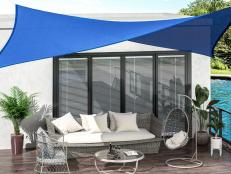How to Make a Closed-Lid Terrarium
Get step-by-step instructions on how to create and care for a decorative terrarium full of lush plants.
Try a new twist on the typical houseplant by building a terrarium. These self-contained ecosystems offer a fascinating look at the delicate balance of plant life.

Terrariums come in endless shapes and sizes, from simple jars to elaborate geometric structures.
- Open terrariums without a top allow greater airflow so they're ideal for arid-loving plants like succulents and cacti.
- Closed terrariums are sealed environments that create a humid microclimate perfect for tropical plants.
Consider how many plants you want to include and the style that suits your space. Glass is the classic choice for terrariums due to its clarity and timeless beauty. It allows for optimal light penetration which is essential for plant growth. However, plastic containers are lighter, less fragile and may be a better choice if a child makes the terrarium. You can choose to use any type of container as long as it is clear. The biggest consideration for a container is if you can fit your hand inside the opening to build the garden.

Terrarium Care 101
- Placement: Choosing the right location for your terrarium is key. Opt for a spot with bright, indirect light. Avoid direct sunlight, as it can overheat your terrarium, harming the plants.
- Maintenance: Prune plants as needed to prevent overcrowding. Remove any yellowing or decaying foliage.
- Watering: This depends on your terrarium type. Closed-lid terrariums are self-watering ecosystems and should rarely need additional moisture. If excessive condensation builds up, remove the lid temporarily. If there isn't enough moisture, spray the soil and moss with water. For open-top terrariums, water sparingly when the soil feels dry to the touch. Avoid overwatering.
Common Terrarium Mistakes
- Don't overwater: This is the most frequent cause of terrarium failure.
- Don't use oversized plants: Select plants that won't quickly outgrow the space.
- Don't place it in direct sunlight: You don't want the terrarium's little ecosystem to overheat.
- Don't ignore signs of trouble: Promptly address yellowing leaves, mold or insect infestations.
How to Build a Closed Terrarium
Tools and Materials
- potting soil
- chopstick
- fairy garden accessories
Plants we used:
- Earth Star (Cryptanthus)
- String of Frogs (Ficus Pumila Quercifolia)
- Nerve Plant (Fittonia)
- Albo Fern (Pteris Cretica)
- Fern (Davallia parvula)
- Pink Panther Plant (Callisia)
- Neanthe Bella Palm (Chamaedorea elegans)

1. Build Drainage Foundation
Start by creating the essential drainage layer for your miniature ecosystem. Add about an inch of clay pebbles, aquarium gravel or river stones to the bottom of the container. This will keep excess water away from delicate plant roots. For a lighter touch, especially in larger terrariums, clay pebbles are a great choice.

2. Add Charcoal
Top the drainage layer with a sprinkle of activated charcoal. This will keep your terrarium fresh and prevent fungal growth.

3. Layer on Moss
Cover the charcoal with a layer of sheet moss, making sure none of the charcoal peeks through. This natural barrier will keep the top layer of soil from filtering down into the drainage layer.

4. Add Soil
Choose a lightweight potting mix free of fertilizer. Lightly dampen the soil and spread a layer about an inch thick over the moss. This provides the perfect base for your plants, giving them room to root and grow — aim for about a quarter of your container's height. Add a bit more moss around the edges, this will help give the terrarium more of a finished look.


5. Insert the Plants
Before you remove the plants from their pots, take a moment to envision your terrarium's layout. Taller plants will look best in the center or near the back. Gently release your plants and carefully loosen the soil from their roots. Give any extra-long roots a trim — this helps your plants stay petite within their new home. Use a chopstick to create small planting holes. Begin around the edges and gradually work your way towards the center of the terrarium. Add more sheet moss in between the plants to cover the soil.


.jpg.rend.hgtvcom.616.462.85.suffix/1717177045736.jpeg)
.jpg.rend.hgtvcom.616.462.85.suffix/1717170564707.jpeg)

6. Add Finishing Touches
Now you can decorate your tiny world with whatever you love. Seashells, rocks and small fairy accessories all add personality and charm to this new miniature garden. Building a terrarium is both a creative and scientific endeavor. Observe your miniature world closely, adjust care as needed and enjoy watching your tiny ecosystem thrive. With a little knowledge and care, you'll have a beautiful, living piece of art to brighten your home.

36 Creative Fairy Garden Ideas 36 Photos
We're head-over-heels for these magical, mini landscapes.
.-Battle-on-the-Beach-courtesy-of-HGTV.-.jpg.rend.hgtvcom.196.196.suffix/1714847929029.jpeg)
